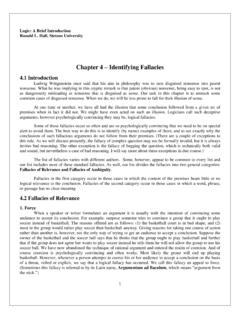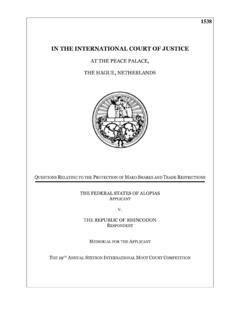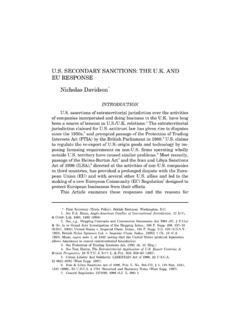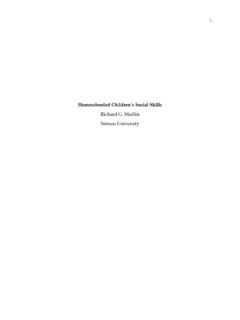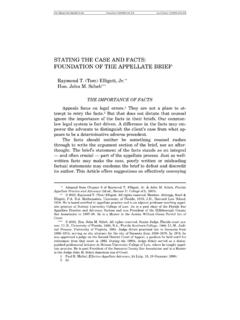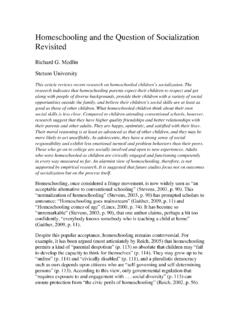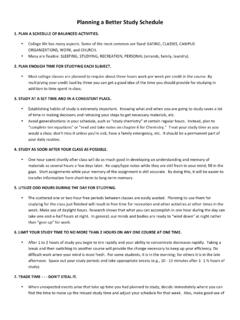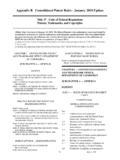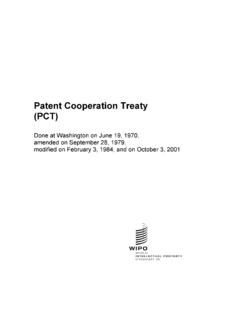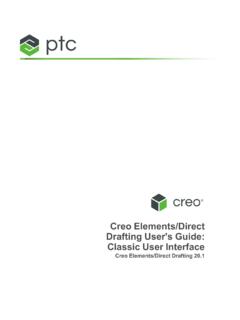Transcription of INTELLECTUAL PROPERTY BASIC CONCEPTS AND PRINCIPLES
1 INTELLECTUAL PROPERTY BASIC CONCEPTS AND PRINCIPLES By Charles F. Carletta, Secretary of the Institute and General Counsel Rensselaer Polytechnic Institute Troy, New York 12180 Phone: (518) 276-6212 Fax: (518) 276-3100 Email: Stetson University College of Law National Conference on Law and Higher Education February 2011 Table of Contents I. COPYRIGHTS .. 1 A. Basis in Constitution .. 1 B. Definition of 1 1. Generally .. 1 2. Original Works of Authorship .. 1 3. What Cannot Be Copyrighted .. 2 C. Computer Programs.
2 2 D. Idea vs. Expression of the Idea .. 2 E. Derivative Works .. 3 F. Rights of a Copyright 3 G. Who Can Claim 3 H. Works Made for Hire .. 3 I. Notice of Copyright .. 4 1. The Berne Convention and the Copyright Notice .. 4 2. The Elements of the Copyright 5 3. Position of Notice .. 6 J. Copyright Registration .. 6 1. Advantages of Registration .. 6 2. One Registration Per Program .. 6 3. General Copyright Information .. 7 4. Form TX (for registration of copyright in literary works, for example) .. 7 K. Duration of Copyright .. 7 L. Copyright Infringement.
3 7 M. Fair Use .. 8 1. The Purpose and Character of the Use Is it Transformative ? .. 8 2. The Nature of the Copyrighted Work.. 8 3. The Amount and Substantiality of the Portion Taken.. 9 4. The Effect of the Use on the Potential Market for the Original Work.. 9 N. Advantages and Disadvantages of Copyright Protection .. 9 1. Advantages .. 9 2. Disadvantages .. 9 II. TRADEMARKS .. 10 A. Terminology .. 10 1. Trademark .. 10 2. Service 10 3. Trade Name .. 11 B. Selection and Adoption of a Mark .. 11 1. Types of Marks .. 11 2. Pre-Adoption Investigation.
4 12 C. Registration of a Mark in the Patent and Trademark Office .. 13 1. Advantages of Federal Registration .. 13 2. Actual Use vs. Intent to Use Applications .. 14 3. Term of a Registration .. 14 D. The Care and Feeding of Marks .. 14 1. Guidelines .. 14 2. Licenses .. 15 IV. PATENTS .. 15 A. Generally .. 15 B. What is Patentable Under Law .. 15 1. Utility 15 2. Design Patents .. 16 3. Plant Patents .. 16 C. What is Not Patentable in the .. 16 D. Pre-Filing Considerations .. 16 1. When to File .. 16 2. Preliminary Patentability Search .. 17 3. First-to-Invent ( ) vs.
5 First-to-File (Foreign) .. 17 4. What Constitutes an Invention .. 17 5. Who Constitutes an Inventor .. 18 E. How Patents are Obtained - Utility Patents .. 18 F. Markings .. 18 G. Provisional Applications .. 18 H. Obtaining Patents in Foreign 19 I. Paris Convention for the Protection of Industrial PROPERTY .. 19 J. Prosecution of Foreign Patent Applications .. 19 K. Annual Taxes and Maintenance Fees .. 19 L. Working of an Invention .. 19 M. Duration of Foreign Patents .. 20 V. TRADE SECRET PROTECTION .. 20 A. Generally .. 20 B. Maintenance of a Trade Secret.
6 20 1. Computer security measures to prevent unauthorized on-line access.. 20 2. Requiring all outside parties to execute non-disclosure or confidentiality agreements.. 20 3. Do not distribute the source code to an end user.. 20 4. Having employees execute non-disclosure agreements.. 21 5. Labeling all sensitive documents, such as drawings , CONFIDENTIAL .. 21 6. Excluding the public from sensitive areas in a plant.. 21 C. Advantages and Disadvantages of Trade Secret Protection .. 21 1. Advantages .. 21 2. Disadvantages .. 21 INTELLECTUAL PROPERTY : BASICS by Charles F.
7 Carletta, 1 INTELLECTUAL PROPERTY BASIC CONCEPTS and PRINCIPLES I. COPYRIGHTS A. Basis in Constitution The law of copyrights arises under the Constitution, Article 1, Section 8, Clause 8: The Congress shall have power .. to promote the progress of science and the useful arts by securing for limited times to authors and inventors the exclusive right to their respective writings and discoveries. The term writings has been given a very broad interpretation such that it now means works of authorship. B. Definition of Copyright 1. Generally Copyright is a federal protection from unauthorized copying or performance (Title 17, United States Code) given to the authors of original works of authorship.
8 Generally, most copyrightable works tend to fall into the following three statutory categories: (a) literary works (including computer programs); (b) pictorial, graphic and sculptural works; and (c) motion pictures and other audiovisual works. Examples of copyrightable subject matter include: songs, including the musical composition, the lyrics and a recorded performance movies (but not their titles) books (but not their titles) games photographs patterns on fabrics labels on products. 2. Original Works of Authorship The work must be the product of original, creative authorship.
9 Original does not mean novel as with patents, it just means that it was not copied from another s work. Originality, even in the slightest degree, is all that is required. Additionally, copyright protection requires some degree of creative authorship. That means that for computer software, just about any program that is more than a few instructions in length is copyrightable. INTELLECTUAL PROPERTY : BASICS by Charles F. Carletta, 2 3. What Cannot Be Copyrighted Works that have not been fixed in a tangible form of expression, such as extemporaneous speeches or performances which have not been written or recorded.
10 Titles of books or magazines (but the contents are protected by copyright), names, short phrases, slogans, brand names or trademarks, colorings or mere listings of ingredients or contents. Ideas, themes, procedures, methods of operation, systems, processes, CONCEPTS , PRINCIPLES or discoveries as opposed to a written description or explanation or illustration of the same. Works consisting entirely of information that is common PROPERTY and containing no original authorship (standard calendars, tape measures, telephone directories, report forms, order forms, tables taken from public documents).
